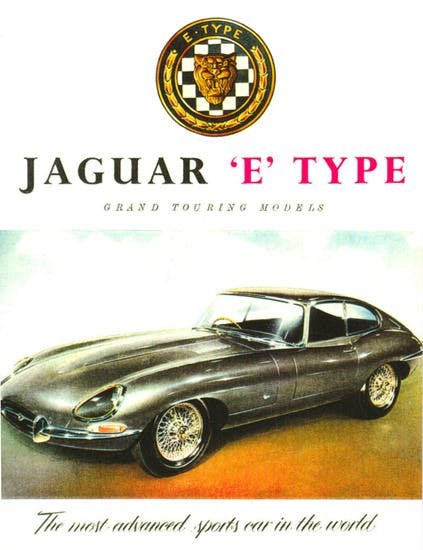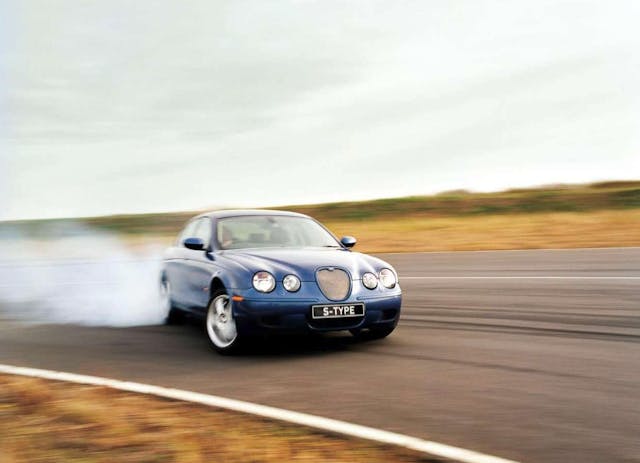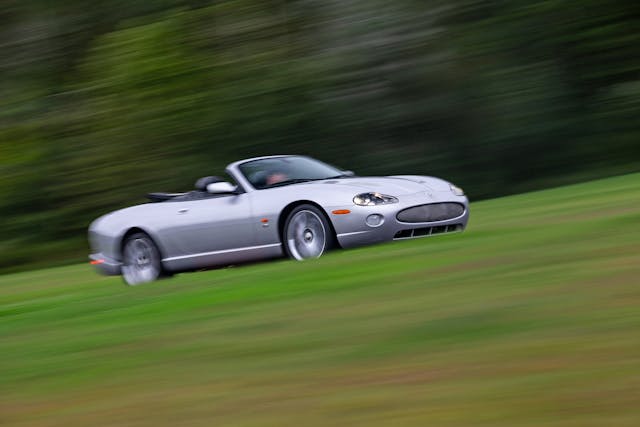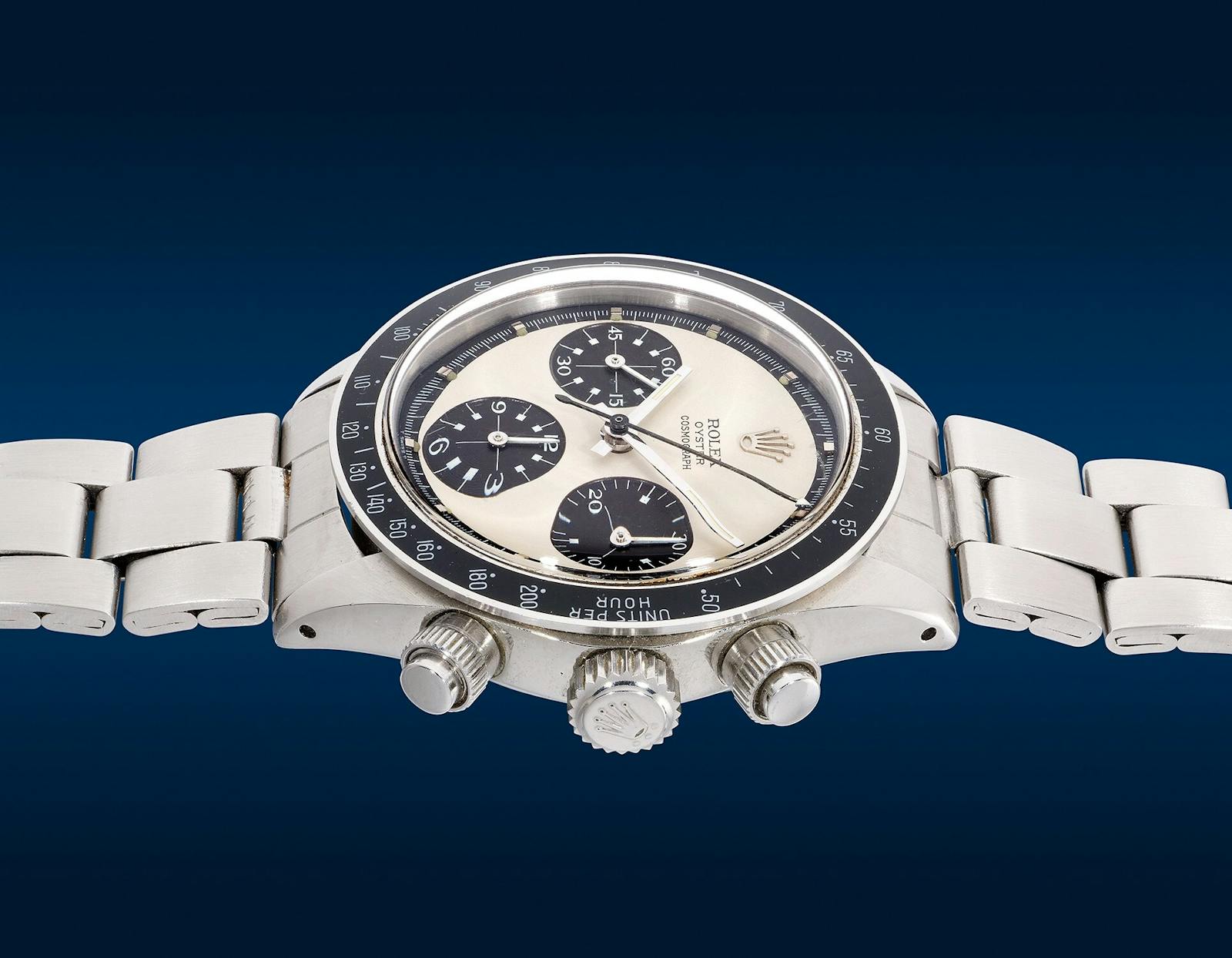Do Classic Jaguars Face a Dark Future?
Jaguar, as a brand, is on the rocks. That’s the growing sense in the collector car industry, at least. For decades, classics like the XK 120, XK 140, XK 150 and E-Type have been mainstays for dealers, brokers, and buyers, but lately they don’t seem to generate the same market excitement they once did. They are getting harder to sell, and over the past five years many prices are either stagnant or decreasing.
Of course, the market is generally softening from its pandemic-era heights, and this is compounded by demographic shifts that are beginning to favor Radwood-era (1980s and 1990s) cars over their predecessors. This isn’t just affecting classic Jaguars—many carbureted V-12 Ferrari road cars, long-hood (1973 and earlier) Porsche 911s, and Austin-Healeys are also seeing relative slumps. But a surprising number of cars from this era are also seeing an uptick in their values. Porsche 356 coupes, C2 Corvettes generally—and ’63 Split-Window coupes especially—and V-6 Ferrari Dinos have increased in value anywhere from 20 percent to 90 percent over the last five years.

So why does the brand, traditionally so prevalent in the hobby, seem to be getting left behind? This is doubtless a complex question, but in the case of Jaguar, several factors appear to be conspiring to collectively dampen interest in what are some of the greatest sports cars of all time.

Promising Starts
Sir William Lyons, who founded Jaguar between the world wars, was famously good at commercializing genuinely compelling products at prices so low they were scarcely believable. Jaguars were world-class cars, delivering sensational looks and performance while consistently pushing cutting-edge technology and selling in much higher volume than other cars that offered the same. Their on-track record drove this point home: Jaguar won the 24 Hours of Le Mans five times in the 1950s (and twice more after that). Only Porsche, Audi, and Ferrari have won Le Mans more times than Jaguar.
Much of that early success came down to engines. In 1948, when everyone else was still essentially warming up their prewar designs, Jaguar released an all-new car, and not only that, it was powered by an engine with twin overhead cams. The car was the XK 120, and its straight-six “XK” engine was so advanced that variants remained in production for over 40 years. Meanwhile, the XK 120 was so good that in its competition trim as the C-Type, it won Le Mans twice. With the same mechanical bits developed further and fitted to a new, even more stunning, more aerodynamic semi-monocoque body in the D-Type, Jaguar won Le Mans three more times.
In 1961, four years after its last victory of the 1950s, Jaguar was selling all that Le Mans–winning goodness to the public in another groundbreaking and gorgeous new sports car, the E-Type. It was even more advanced, thanks to the addition of independent rear suspension. A few months after the E-Type arrived, Jag put those same technical components into a full-sized sedan, the Mark X.

It’s difficult to overstate the impact of the E-Type. With semi-monocoque construction, a twin-cam engine, four-wheel disc brakes, and fully independent suspension, it was, as Jaguar pointed out in advertisements, the most advanced sports car in the world. No other single car combined all these characteristics at any price: not Porsche, not Mercedes, not Maserati, not Aston Martin, not even Ferrari. And the price of the Jag? Around £2000 in its home market (a relatively modest $46,600 in today’s dollars). That meant it was 80 percent the cost of a Porsche 356, half as expensive as an Aston Martin DB4, and a third as much as a Ferrari 250. It was quicker, faster, and better looking than almost all of them, too. Even Enzo Ferrari famously lavished praise on the car upon its debut, and decades later, an E-Type roadster joined New York’s Museum of Modern Art.
With credentials like these, it’s no surprise that Jaguar sold more than 72,000 E-Types during a 14-year production run. The cars peaked in the 1960s, before American regulations started strangling performance and spoiling their looks. Even so, Jaguar was on top of the world during this period, and it wasn’t only thanks to the E-Type. Jaguar sedans had temptingly similar underpinnings to the sports cars, and if buyers thought those features were advanced in something like the E-Type, they were downright space-age in a sedan. Vast expanses of wood and leather epitomized British luxury, while beautiful and distinctive exterior styling and superb value for money gave four-door Jaguars a unique appeal that no other car in the world could quite match.

Changing Fortunes
And then, everything stopped. Not literally, but Jaguar’s evolution largely did. The 1970s saw the E-Type replaced by the XJS, which was fresh and contemporary but much more grown up. If the E-Type was a sports car with the heart of a Le Mans racer, the XJS was the European version of a personal luxury car. The seminal XJ6 also arrived in 1968, right-sizing the Jaguar sedan formula and setting the world alight, but it remained in production for a full 18 years before being replaced by a car that was really just a 1980s take on the exact same concept. At the corporate level, getting caught up in the woes of British Leyland in the 1970s and eventually being bought by Ford in 1990 did Jaguar few favors.
Little had changed by the early 2000s. Jaguars, despite having contemporary technology under the skin, offered an aesthetic experience that had become anachronistic. They felt like a caricature of olde-worlde England, which gave them virtually no sizzle to youths and younger buyers, who preferred the forward-looking modernity of German or Japanese luxury cars. If those cars were modernist houses of concrete and glass, then Jaguars were Tudors with thatched roofs.
Jaguar set out to reinvent itself by building a new, modern identity starting with the new XF in 2007, followed by other sedan models, entries into the lucrative SUV market, and a new sports car, the F-Type. These cars simply never resonated completely with buyers. Their identity wasn’t strong enough, the engineering and reliability not good enough, and the interiors not nice enough. Unlike Land Rover, who has so effectively modernized the Range Rover while somehow preserving a feeling of Britishness, Jaguar’s post-millennium effort at rebirth lacked the relevance and raw desirability to drive consumers into showrooms in substantial numbers.
Looking forward, it’s unclear (especially given current consumer preferences) whether Jaguar’s assertion of an all-electric future will help or hurt the values of its classic models. Its aspirations to head further upmarket may help the brand’s financial viability, but the impact of any future success on the marque’s past models will depend wholly on whether its execution inserts the kind of passion that brings enthusiasts into the fold.

Struggling for Relevance
Modern consumers have known only two Jaguars: the charming but backwards-looking neo-classical version of the 1980s–2000s, and the modern but ultimately uninspiring rebirth that began in 2007. Unless they consciously seek out classic cars, these buyers won’t be familiar with the greatest Jaguars of all: The ones that did not look fondly toward the past or unconvincingly toward the future, instead descending directly from Le Mans race cars and offering the world’s most advanced motoring experience in a competitively priced, beautiful, contemporary, and authentic wrapper.
One of the troubles for Jaguar’s classics is that their collectibility (and that of all collector cars) is driven by their relevance to enthusiasts. Not enough of today’s enthusiasts associate Jaguar with their core automotive memories—the kind that would drive them to loop back and buy something from a brand they desired in their youth.
BMW provides a stark contrast—the brand retains enthusiastic and growing appeal among collectors. Twenty years ago, a new 7-Series costs much more than an M3. Today, the M3 is worth more. Why? Because many more enthusiasts want a 2004 M3 than want a 2004 745Li. When cars become old enough, the market for them is composed almost exclusively of enthusiasts.

Meanwhile, few Jaguars have set enthusiast hearts alight, even looking back 50 years. There are of course evangelists of the XJS, XK8/XKR, and XJ40/X300/X308 generations of the XJ, and likely other models besides. But we are small in number and a little bit weird. There aren’t enough of us to form an entire new generation of Jaguar fans, especially when other brands have done such a good job of connecting their enthusiast-driven identity to the mainstream. Think Porsche, Ferrari, Lamborghini, and Land Rover.
As for the classic Jaguars of the company’s golden era, their lack of connection to today’s enthusiasts is compounded by the fact that they sold so well when new. Corvettes of the same period sold in large numbers. Porsches and Alfa Romeos did, too, albeit to a lesser extent. But virtually every model of Ferrari, Aston Martin, and Maserati from the 1950s to early 1970s ranged from a few hundred to barely a few thousand units. Given how comparatively abundant Jaguars are, it takes a larger number of buyers to sustain appreciation, and there just aren’t enough such people in the current market. If they had made a few hundred E-Types or XKs, they’d all be worth at least a million dollars. But they didn’t, and they aren’t.

The Silver Lining
While it’s disappointing to see Jaguar values languish, there are upsides. What made them so compelling against their competitors in the 1950s and ’60s is still true today. They represent great value for money given their intrinsic characteristics, and softening prices make them an even greater value.
If you’ve dismissed Jaguars as “old people cars,” take a closer look at them. And if you’ve seen the light and own one, share it with as many people as possible. Let them hear it, ride in it, and form those memories that will reshape them from a car enthusiast into a Jaguar enthusiast. If Jaguar as a company can’t endear itself to a new crop of car fans, it’s up to those of us who know better to do that work instead.
Regardless of their values, the experience provided by these cars has lost none of its appeal. To look at, ride in, or drive an E-Type is one of motoring’s great pleasures, and it happens to be one of the precious few automotive experiences that is getting more, rather than less, financially accessible.
Derek Tam-Scott is a used car salesman and car content grump.
***
Check out the Hagerty Media homepage so you don’t miss a single story, or better yet, bookmark it. To get our best stories delivered right to your inbox, subscribe to our newsletters.



Boy, what a downer. I’ve had a 1986 Jaguar XJ-S about 4 years now. It’s been well cared for it’s whole life, not a spot of rust anywhere, and to me it really is an impressive car. It drives like new, the quiet acceleration is just FUN. It’s the only classic car I’ve owned, and bought it specifically because it had a V12. I joined the local Jaguar club and began to realize that this car has gotten absolutely no love from anyone, even Jaguar enthusiasts. It’s like a bastard step child. Being a mechanically minded guy I’ve had no trouble keeping it in top form, but really it hasn’t asked for much. Most of what I have done is simply maintenance done more to keep me busy than the car actually needing anything. When I first got it I broought it to a shop that specializes in old Jaguars. The owner told me my car was phenominal, That was good to hear, even though the XJ-S isn’t worth much and apparently losing value steadily. I didn’t buy it as an investment, so I guess that’s something. Hopefully it will become more of a collector car when more of them end up in the scrapyard. I guess I will just drive the hell out of it.
To me, there is nothing connecting classic Jaguar to current Jaguar, unlike others like Corvette and Land Rover. I love the idea of Jaguar until I get in one and there is nothing special about it…plain carpet, blah wood or metal trim and so on.
Others have proven you don’t need them the exact looks of the past, but you do need something desirable in the now to continue to pull forward the past.
Let’s put it this way. The XKE is like a China doll. Beautiful but fragile.
There are reasons so many Jags have Chevy conversions and I even know one Pontiac conversion. You can replace a fragile engine with a complete solid engine for the cost of a bare Jag head casting.
We had a 12 cylinder here that dropped a valve seat. It was rebuilt and then the other head gave up. It now has a 428 Pontiac with no issues.
They go up. They go down. Like any market there is an ebb and flow. Many factors are hitting the collector car market right now. A couple of years ago many were saying the same things about 356s and air-cooled 911s.
I own a 70 e-type convertible. I have to say I love driving the car, I also own a 68 Camaro convertible and it drives rough compared to the jag, hydraulic clutch, disc brakes and a great suspension make the Jag easy to drive and smooth as silk. My tri-carb European spec is quick to boot. I Like the Camaro for different reasons and like the jag they made many of them. Yet prices are high for good examples. I would expect the younger generation’s would favor the Camaro but owning both I can tell you the Jag is a better car and as for maintenance is more reliable than people think. I love all classics but will not part with the Jag.
Jaguar XKE. Had a ’68 Series 1 1/2 FHC that I bought in ’80. Beautiful car, handled well, sounded great, torque out the kazoo and certainly a crumpet catcher without peer… but oh the maintenance! In the almost 2 years that I owned it, I don’t think I went a full week without having to do something to it. Hence the short ownership; just got too frustrating. I’ve been tempted to go for a swim again many time, but I remember all the pain that went with that joy and have resisted the plunge. I now have four Porsches. They are like Apple products — they just work. But still, the XKE is one the greats. Maybe if…
Jaguars always had an appeal to me but never owned one ’till I saw TV ads for a beautiful roadster and I had to have it. No it wasn’t an E Jag, it was the F-Type. I bought a 2014 F-Type S and it is still my favorite car to drive out of my collection of over a dozen cars from the 1930’s to modern. A supercharged V6 that is almost a second faster in the quarter than my hemi Challenger. Love it.
I owned 2 e-types and have to say that the short wheelbase coupes and convertibles will always be loved. I was always talking to admirers, many of whom had no idea what my car even was. To boot, my ’71 Series II FHC was a blast to drive, beautiful to look at, awesome to listen to, and a dream to sit in. Real leather, wool, wood and metal all over the place. It never left me stuck, but I averaged $6k per year in upgrades, maintenance, and repairs over 10 years. Appreciation covered most of that, so my total cost of ownership was $2k per year. Totally worth it. Without appreciation? Still worth it to me, but not to my wife. Hence my 2024 C8 purchase, which will probably cost me more per year for insurance, property taxes and depreciation than my e-type cost in maintenance. Bottomline is if you want a dream car, it will likely cost you in one way or another, but the smiles you will get and receive in an e-type are priceless.
Being a psychotic masochistic lover of Jaguars, (XK 150 dh, S1 XKE ots, XJS ots and XK conv),I really do not care about the market. I do not buy collector cars based on the market, I love the sound of the engines The rush of acceleration and the smell, of leather. I will let my daughter worry about the value after I am gone. I have a really fond memory of starting to pass a corvette in my XJS many years ago on a long straight hill, when I was alongside the other guy he decided that he wasn’t going to let me get around him he and hit the accelerator. I pushed mine to the floor and left him way behind. The transmission did not even kick down to a lower gear, the torque of that V12 just pushed me way out front. I thought to myself ” Bud, you just thought you had a fast car” I will add this thought- Collect what you love, because you love it. Let your heirs worry about the return, and you will never be disappointed.
Those last two sentences! 👍👍👍👏👏👏
Even if the heirs only realize a portion of what you have valued your car(s), keep in mind that when, as an heir, your basis is zero, whatever it brings at sale is 100% profit.
I’m currently the owner of a 1969 XJ6 4.2 – a very early LHD one. It was my father’s, although I’ve worked on it some. Currently it’s sitting in a garage at the cottage after not having run for around 10 years. It’s a maintenance-intensive car, and I really don’t have the time to maintain it anymore.
When it runs, it’s gorgeous – if any car can be said to have “presence”, it’s this one. Not pavement-ripping power, but will transport you at 100+MPH all day.
When it doesn’t run, it’s Hell. Complex carb setup, electrical system by Lucas, inboard disc brakes, etc.
It’s currently for sale for what Dad paid for it in 1995 – $5,000.
My taste runs more towards continental vehicles – my other vehicles are a 1988 Porsche 944 Turbo, 2000 BMW K1200RS, and 2000 Ducati ST4. Too bad Hagerty doesn’t offer classic bike insurance…
Looking at current auctions on your marketplace and BAT, you’re likely correct regarding the classic Jaguar values – whether they result in actual sales or not. And, as a whole, the earlier shine on EVs by the masses is currently somewhat tarnished. That has to hurt Jaguar as a professed to a 100% EV brand.
Regardless, as you state, taking our e-type FHC out always generates a lot of attention, where ever. But, surprisingly to me, our XJS 2+2 conv is now doing the same. And I have 3 valid standing offers for it for whenever we’re ready to let it go. (Which isn’t anytime soon.)
I’m not real sure this is an accurate analysis of the overall market for classic Jaguars. No offense but negative titles get a lot more clicks than positive ones, so it’s never surprising to see that slant on internet based analyses.
Overall the prices of early jags are up over the last few years with I believe the first $1M auction sale of a production EType happening just last August. Yes prices were soft on BAT in December but I attribute that to over saturation of offerings at the time-they seem to have rebounded since-but the market is far larger than just BAT, or the other auctions.
It wasn’t long ago that I made the observation that the market was upside down with big Healeys bringing substantially more than ETypes-and sorry Healey guys the EType is a far superior car. This corrected a couple years back.
These cars will always be desirable. no important collection is complete without an EType.
I still have fond memories of my XK 150 Roadster. It went to the ski area, took the kids to swimming lessons and to the racetrack at over 100 MPH at times to attend events. It was our only car. I think that Jaguar is experiencing the same future as Maserati who is having great difficulty selling cars, at any price. It has been upstaged by McLaren and the likes however the only McLaren I would want to own is a MC-6A or a MC-8.
Like the author, I also spent my career in the car business. I started selling cars for Toyota in 1978 and spent most of my career with Toyota and Lexus. Even then we know Toytota’s had bullet proof reliability. I was spoiled. Early on in my sales career I had the misfortune of selling a used Jaguar sedan. I don’t recall the model, only that it was a gold color with a parchment interior. I made the mistake of promising the buyer I would have the door lock repaired because it wasn’t working. When the technician remove the door panel it looked like the design was engineered by Rube Goldberg. The array of levers and such was incredible and likely contributed to the fragile nature of the mechanism. We got it fixed but that was just the beginning of the problems with the car. It seemed every time I turned around the customer was back with another problem. I swore to myself I would never sell another Jaguar. And I didn’t. Wherever I worked, when we had a used Jaguar for sale and someone inquired about it, I begged off said I wan’t too familiar with Jaguars and turned them over to another salesman. More often than not, the pattern repeated itself. Problems. Before I started selling cars I had the misfortune of owning a Fiat 600. It made Jaguars look downright reliable. After Fiat left the US market t took 40 years for the collective memory of what poor cars Fiat manufactured to fade. And true to form, now that they are back the initial sales figures have dipped significantly and once again Fiat occupies among the lowest reliability ratings in Consumer Reports. Beautiful as classic Jaguars are, most people prefer cars that will start and stop reliably rather than cars whose owners take perverse pleasure in commiserating over. It must be part of the allure.
Interesting that a no-liker follows the Jag discussion. Someone has a secret love affair but .. oh well. I have a 59 XK159 DHC and a 2002 XJ8VDP. Both are like beautiful women, crazy every now and then but worth it when you are in need of a thrill.
XK150, not 159.
I’m a sucker for Brit cars. I’ve owned a Triumph Spitfire and TR6, Jag XJ6, XJ8, X Type, and now a 1997 XK8. I’ve enjoyed the fun of the 2 converts and learned to work on them through too much experience. The Jags have been a pleasure to “motor” and, fortunately, not too expensive to keep running. The XK8 Coupe is a hobby collector car in Carnival Red that provides practice waxing and check writing for the A/C, power steering, CD player, and minor nifnaw, but what can you expect from any 27 year old car?